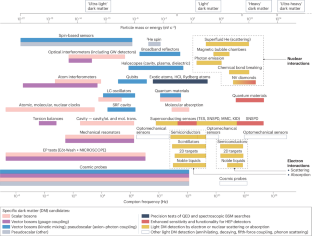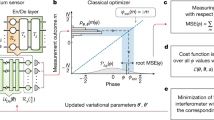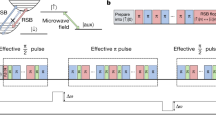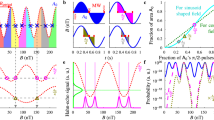Abstract
Quantum sensing uses properties of quantum mechanics to go beyond what is possible with traditional measurement techniques. In particle physics, key problems in which quantum sensing can have a vital role include neutrino properties, tests of fundamental symmetries (Lorentz invariance and the equivalence principle, searches for electric dipole moments and possible variations of the fundamental constants), the search for dark matter and testing ideas about the nature of dark energy. Quantum sensor technologies using atom interferometry, optomechanical devices, or atomic and nuclear clocks are inherently relevant for low-energy physics, but other platforms, such as quantum dots, superconducting devices or spin sensors, might also be useful in future high-energy particle physics detectors. This Perspective explores the opportunities for these technologies in future particle physics experiments and outlines the challenges that could be tackled through collaborative efforts.
This is a preview of subscription content, access via your institution
Access options
Access Nature and 54 other Nature Portfolio journals
Get Nature+, our best-value online-access subscription
$29.99 / 30 days
cancel any time
Subscribe to this journal
Receive 12 digital issues and online access to articles
$99.00 per year
only $8.25 per issue
Buy this article
- Purchase on Springer Link
- Instant access to full article PDF
Prices may be subject to local taxes which are calculated during checkout

Similar content being viewed by others
References
Altarelli, G. Collider physics within the Standard Model: a primer. Preprint at https://arxiv.org/abs/1303.2842 (2013).
Bass, S. D., De Roeck, A. & Kado, M. The Higgs boson implications and prospects for future discoveries. Nat. Rev. Phys. 3, 608–624 (2021).
Doser, M. et al. Quantum systems for enhanced high energy particle physics detectors. Front. Phys. 10, 887738 (2022).
Chakrabarti, S., Gonzalez, A., Eikenberry, S. et al. Real-time cosmology with high precision spectroscopy and astrometry. Preprint at https://arxiv.org/abs/2203.05924 (2022).
Clerk, A. A., Devoret, M. H., Girvin, S. M., Marquardt, F. & Schoelkopf, R. J. Introduction to quantum noise, measurement, and amplification. Rev. Mod. Phys. 82, 1155–1208 (2010).
Liu, Y.-C., Huang, K., Xiao, Y.-F., Yang, L. & Qiu, C.-W. What limits limits? Natl Sci. Rev. 8, nwaa210 (2021).
Giovannetti, V., Lloyd, S. & Maccone, L. Quantum-enhanced measurements: beating the standard quantum limit. Science 306, 1330–1336 (2004).
Gray, H. M. & Terashi, K. Quantum computing applications in future colliders. Front. Phys. 10, 864823 (2022).
Georgescu, I. M., Ashhab, S. & Nori, F. Quantum simulation. Rev. Mod. Phys. 86, 153 (2014).
Bañuls, M. C. et al. Simulating lattice gauge theories within quantum technologies. Eur. Phys. J. D 74, 165 (2020).
Bauer, C. W., Davoudi, Z., Klco, N. & Savage, M. J. Quantum simulation of fundamental particles and forces. Nat. Rev. Phys. 5, 420–432 (2023).
Shimazoe, K. et al. Quantum sensing for biomedical applications. In 2021 IEEE Nuclear Science Symposium and Medical Imaging Conference (NSS/MIC) 1–4 https://doi.org/10.1109/NSS/MIC44867.2021.9875702 (IEEE, 2021).
Hiesmayr, B. C. & Moskal, P. Genuine multipartite entanglement in the 3-photon decay of positronium. Sci. Rep. 7, 15349 (2017).
Sharma, S., Kumar, D. & Moskal, P. Decoherence puzzle in measurements of photons originating from electron-positron annihilation. Acta Phys. Polon. A 142, 428–435 (2022).
Aslam, N. et al. Quantum sensors for biomedical applications. Nat. Rev. Phys. 5, 157–169 (2023).
Overstreet, C., Asenbaum, P. & Kasevich, M. A. Physically significant phase shifts in matter-wave interferometry. Am. J. Phys. 89, 324 (2021).
Safronova, M. S. in Springer Handbook of Atomic, Molecular, and Optical Physics (ed. Drake, G. W. F.) 471–484 (Springer, 2023).
Blaum, K., Eliseev, S. & Sturm, S. Perspectives on testing fundamental physics with highly charged ions in penning traps. Quantum Sci. Technol. 6, 014002 (2016).
Peik, E. et al. Nuclear clocks for testing fundamental physics. Quantum Sci. Technol. 6, 034002 (2021).
Jackson Kimball, D. F. et al. Probing fundamental physics with spin-based quantum sensors. Phys. Rev. A 108, 010101 (2023).
Berlin, A. et al. Searches for new particles, dark matter, and gravitational waves with SRF cavities. Preprint at https://arxiv.org/abs/2203.12714 (2022).
Laucht, A. et al. Roadmap on quantum nanotechnologies. Nanotechnology 32, 162003 (2021).
ECFA Detector R&D Roadmap Process Group The 2021 ECFA Detector Research and Development Roadmap CERN report CERN-ESU-017 (CERN Document Server, 2020); https://cds.cern.ch/record/2784893.
Safronova, M. S. et al. Search for new physics with atoms and molecules. Rev. Mod. Phys. 90, 025008 (2018).
Paul, N., Bian, G., Azuma, T., Okada, S. & Indelicato, P. Testing quantum electrodynamics with exotic atoms. Phys. Rev. Lett. 126, 173001 (2021).
Cecil, T., Irwin, K., Maruyama, R., Pyle, M. & Zorzetti, S. Report of the topical group on quantum sensors for Snowmass 2021. Preprint at https://arxiv.org/abs/2208.13310 (2022).
Antypas, D. et al. New horizons: scalar and vector ultralight dark matter. Preprint at https://arxiv.org/abs/2203.14915 (2022).
Berlin, A. et al. Axion dark matter detection by superconducting resonant frequency conversion. J. High Energy Phys. 07, 088 (2020).
Chou, A. et al. The future of US particle physics: report of the 2021 Snowmass Community Study. Preprint at https://arxiv.org/abs/2211.09978 (2022).
Battaglieri, M. et al. US cosmic visions: new ideas in dark matter 2017: community report. Preprint at https://arxiv.org/abs/1707.04591 (2017).
Antoniadis, J. et al. The International Pulsar Timing Array second data release: search for an isotropic gravitational wave background. Mon. Not. R. Astron. Soc. 510, 4873–4887 (2022).
Martens, W., Khan, M. & Bayle, J.-B. LISAmax: improving the low-frequency gravitational-wave sensitivity by two orders of magnitude. Class. Quantum Gravity 40, 195022 (2023).
Aggarwal, N. et al. Challenges and opportunities of gravitational-wave searches at MHz to GHz frequencies. Living Rev. Relativ. https://doi.org/10.1007/s41114-021-00032-5 (2021).
Balantekin, A. B. & Kayser, B. On the properties of neutrinos. Ann. Rev. Nucl. Part. Sci. 68, 313–338 (2018).
Workman, R. L. et al. Review of particle physics. Prog. Theor. Exp. Phys. 2022, 083C01 (2022).
Dolinski, M. J., Poon, A. W. P. & Rodejohann, W. Neutrinoless double-beta decay: status and prospects. Ann. Rev. Nucl. Part. Sci. 69, 219–251 (2019).
Armstrong, W. R. et al. CUPID pre-CDR. Preprint at https://arxiv.org/abs/1907.09376 (2019).
Armatol, A. et al. Toward CUPID-1T. Preprint at https://arxiv.org/abs/2203.08386 (2022).
Gastaldo, L. et al. The electron capture in 163Ho experiment ECHo: an overview. J. Low Temp. Phys. 176, 876–884 (2014).
Ullom, J. et al. Measuring the electron neutrino mass using the electron capture decay of 163Ho, in 2022 Snowmass Summer Study. Preprint at https://arxiv.org/abs/2203.07572 (2022).
Aker, M. et al. Direct neutrino-mass measurement with sub-electronvolt sensitivity. Nat. Phys. 18, 160–166 (2022).
Canning, J. A. L., Deppisch, F. F. & Pei, W. Sensitivity of future tritium decay experiments to New Physics. J. High Energy Phys. 03, 144 (2023).
Martoff, C. J. et al. HUNTER: precision massive-neutrino search based on a laser cooled atomic source. Quantum Sci. Technol. 6, 024008 (2021).
Friedrich, S. et al. Limits on the existence of sub-MeV sterile neutrinos from the decay of 7Be in superconducting quantum sensors. Phys. Rev. Lett. 126, 021803 (2021).
Betti, M. G. et al. Neutrino physics with the PTOLEMY project: active neutrino properties and the light sterile case. J. Cosmol. Astropart. Phys. 07, 047 (2019).
Cairncross, W. B. & Ye, J. Atoms and molecules in the search for time-reversal symmetry violation. Nat. Rev. Phys. 1, 510–521 (2019).
Roussy, T. S. et al. An improved bound on the electron’s electric dipole moment. Science 381, 46 (2023).
Andreev, V. et al. Improved limit on the electric dipole moment of the electron. Nature 562, 355–360 (2018).
Pendlebury, J. M. et al. Revised experimental upper limit on the electric dipole moment of the neutron. Phys. Rev. D 92, 092003 (2015).
Alarcon, R. et al. Electric dipole moments and the search for new physics. Preprint at https://arxiv.org/abs/2203.08103 (2022).
Grasdijk, O. et al. CeNTREX: a new search for time-reversal symmetry violation in the 205Tl nucleus. Quantum Sci. Tech. 6, 044007 (2021).
Garcia Ruiz, R. F. et al. Spectroscopy of short-lived radioactive molecules. Nature 581, 396–400 (2020).
Arrowsmith-Kron, G. et al. Opportunities for fundamental physics research with radioactive molecules. Preprint at https://doi.org/10.48550/arXiv.2302.02165 (2023).
Augenbraun, B. et al. Direct laser cooling of polyatomic molecules. Advances in Atomic, Molecular, and Optical Physics 72, 89–182 (2023).
Aoyama, T., Kinoshita, T. & Nio, M. Revised and improved value of the QED tenth-order electron anomalous magnetic moment. Phys. Rev. D 97, 036001 (2018).
Fan, X., Myers, T. G., Sukra, B. A. D. & Gabrielse, G. Measurement of the electron magnetic moment. Phys. Rev. Lett. 130, 071801 (2023).
Parker, R. H., Yu, C., Zhong, W., Estey, B. & Müller, H. Measurement of the fine-structure constant as a test of the Standard Model. Science 360, 191 (2018).
Morel, L., Yao, Z., Cladé, P. & Guellati-Khélifa, S. Determination of the fine-structure constant with an accuracy of 81 parts per trillion. Nature 588, 61–65 (2020).
Kozlov, M. G., Safronova, M. S., Crespo López-Urrutia, J. R. & Schmidt, P. O. Highly charged ions: optical clocks and applications in fundamental physics. Rev. Mod. Phys. 90, 045005 (2018).
Charlton, M., Eriksson, S. & Shore, G. M. Antihydrogen and Fundamental Physics (Springer, 2020).
Will, C. M. The confrontation between general relativity and experiment. Living Rev. Rel. 17, 4 (2014).
Touboul, P. et al. MICROSCOPE mission: final results of the test of the equivalence principle. Phys. Rev. Lett. 129, 121102 (2022).
Wagner, T. A., Schlamminger, S., Gundlach, J. H. & Adelberger, E. G. Torsion-balance tests of the weak equivalence principle. Class. Quantum Gravity 29, 184002 (2012).
Asenbaum, P., Overstreet, C., Kim, M., Curti, J. & Kasevich, M. A. Atom-interferometric test of the equivalence principle at the 10−12 level. Phys. Rev. Lett. 125, 191101 (2020).
Bassi, A. et al. STE-QUEST: Space Time Explorer and Quantum Equivalence Principle Space Test. Preprint at https://arxiv.org/abs/2211.15412 (2022).
Anderson, E. et al. Observation of the effect of gravity on the motion of antimatter. Nature 621, 716–722 (2023).
Amsler, C. et al. Pulsed production of antihydrogen. Commun. Phys. 4, 19 (2021).
van der Werf, D. P. The GBAR experiment. Int. J. Mod. Phys. Conf. Ser. 30, 1460263 (2014).
Mariazzi, S. et al. Toward inertial sensing with a 23S positronium beam. Eur. Phys. J. D 74, 79 (2020).
Gerber, S., Doser, M. & Comparat, D. Pulsed production of cold protonium in Penning traps. Phys. Rev. A 100, 063418 (2019).
Borchert, M. et al. A 16-parts-per-trillion measurement of the antiproton-to-proton charge-mass ratio. Nature 601, 53–57 (2022).
Kornakov, G. et al. Synthesis of cold and trappable fully stripped highly charged ions via antiproton-induced nuclear fragmentation in traps. Phys. Rev. C 107, 034314 (2023).
Safronova, M. S. The search for variation of fundamental constants with clocks. Ann. Phys. 531, 1800364 (2019).
Uzan, J.-P. Varying constants, gravitation and cosmology. Living Rev. Rel. 14, 2 (2011).
Lange, R. et al. Improved limits for violations of local position invariance from atomic clock comparisons. Phys. Rev. Lett. 126, 011102 (2021).
Hart, L. & Chluba, J. New constraints on time-dependent variations of fundamental constants using Planck data. Mon. Not. R. Astron. Soc. 474, 1850–1861 (2018).
Ubachs, W. Search for varying constants of nature from astronomical observation of molecules. Space Sci. Rev. 214, 3 (2018).
Sanner, C. et al. Optical clock comparison for Lorentz symmetry testing. Nature 567, 204–208 (2019).
Dreissen, L. S. et al. Improved bounds on Lorentz violation from composite pulse Ramsey spectroscopy in a trapped ion. Nat. Commun. 13, 7313 (2022).
Barontini, G. et al. Measuring the stability of fundamental constants with a network of clocks. EPJ Quant. Technol. 9, 12 (2022).
Delva, P., Hees, A. & Wolf, P. Clocks in space for tests of fundamental physics. Space Sci. Rev. 212, 1385–1421 (2017).
Schkolnik, V. et al. Optical atomic clock aboard an Earth-orbiting space station (OACESS): enhancing searches for physics beyond the standard model in space. Quantum Sci. Technol. 8, 014003 (2023).
Beeks, K. et al. The thorium-229 low-energy isomer and the nuclear clock. Nat. Rev. Phys. 3, 238–248 (2021).
Kraemer, S. et al. Observation of the radiative decay of the 229Th nuclear clock isomer. Nature 617, 706–710 (2023).
Bertone, G. & Tait, T. M. P. A new era in the search for dark matter. Nature 562, 51–56 (2018).
Baudis, L. The search for dark matter. Eur. Rev. 26, 70–81 (2018).
Lehnert, K. Quantum enhanced metrology in the search for fundamental physical phenomena. SciPost Phys. Lect. Notes 40, 1 (2022).
Buchmueller, O. et al. Snowmass 2021: quantum sensors for HEP science — interferometers, mechanics, traps, and clocks. Preprint at https://arxiv.org/abs/2203.07250 (2022).
Ebadi, R. et al. Directional detection of dark matter using solid-state quantum sensing. AVS Quantum Sci. 4, 044701 (2022).
Attanasio, A. et al. Snowmass 2021 white paper: the Windchime Project. Preprint at https://arxiv.org/abs/2203.07242 (2022).
Essig, R. et al. Snowmass2021 Cosmic Frontier: the landscape of low-threshold dark matter direct detection in the next decade. Preprint at https://arxiv.org/abs/2203.08297 (2022).
Adams, C. B. et al. Axion dark matter, Snowmass 2021. Preprint at https://arxiv.org/abs/2203.14923 (2022).
Jaeckel, J., Rybka, G. & Winslow, L. Report of the Topical Group on Wave Dark Matter for Snowmass 2021. Preprint at https://arxiv.org/abs/2209.08125 (2022).
Chou, A. S. et al. Snowmass Cosmic Frontier report, Snowmass 2021. Preprint at https://arxiv.org/abs/2211.09978 (2022).
Backes, K. M. et al. A quantum-enhanced search for dark matter axions. Nature 590, 238–242 (2021).
Roussy, T. S. et al. Experimental constraint on axionlike particles over seven orders of magnitude in mass. Phys. Rev. Lett. 126, 171301 (2021).
Graham, P. W. et al. Spin precession experiments for light axionic dark matter. Phys. Rev. D 97, 055006 (2018).
Arvanitaki, A., Huang, J. & Van Tilburg, K. Searching for dilaton dark matter with atomic clocks. Phys. Rev. D 91, 015015 (2015).
Filzinger, M. et al. Improved limits on the coupling of ultralight bosonic dark matter to photons from optical atomic clock comparisons. Phys. Rev. Lett. 130, 253001 (2023).
Banerjee, A. et al. Oscillating nuclear charge radii as sensors for ultralight dark matter. Preprint at https://arxiv.org/abs/2301.10784 (2023).
Beloy, K. et al. Frequency ratio measurements with 18-digit accuracy using a network of optical clocks. Nature 591, 564 (2021).
Badurina, L. et al. Prospective sensitivities of atom interferometers to gravitational waves and ultralight dark matter. Phil. Trans. A 380, 20210060 (2021).
Alonso, I. et al. Cold atoms in space: community workshop summary and proposed road-map. EPJ Quant. Technol. 9, 30 (2022).
Kialka, F., Fein, Y. Y., Pedalino, S., Gerlich, S. & Arndt, M. A roadmap for universal high-mass matter-wave interferometry. AVS Quantum Sci. 4, 020502 (2022).
Aghanim, N. et al. Planck 2018 results. VI. Cosmological parameters. Astron. Astrophys. 641, A6 (2020); erratum 652, C4 (2021).
Altarelli, G. Neutrino 2004: concluding talk. Nucl. Phys. B Proc. Suppl. 143, 470–478 (2005).
Bass, S. D. & Krzysiak, J. Vacuum energy with mass generation and Higgs bosons. Phys. Lett. B 803, 135351 (2020).
Burrage, C. & Sakstein, J. Tests of chameleon gravity. Living Rev. Rel. 21, 1 (2018).
Lee, J. G., Adelberger, E. G., Cook, T. S., Fleischer, S. M. & Heckel, B. R. New test of the gravitational 1/r2 law at separations down to 52 μm. Phys. Rev. Lett. 124, 101101 (2020).
Jaffe, M. et al. Testing sub-gravitational forces on atoms from a miniature, in-vacuum source mass. Nat. Phys. 13, 938 (2017).
Sabulsky, D. O. et al. Experiment to detect dark energy forces using atom interferometry. Phys. Rev. Lett. 123, 061102 (2019).
Xu, V. et al. Probing gravity by holding atoms for 20 seconds. Science 366, 745–749 (2019).
Qvarfort, S., Rätzel, D. & Stopyra, S. Constraining modified gravity with quantum optomechanics. New J. Phys. 24, 033009 (2022).
Sponar, S., Sedmik, R. I. P., Pitschmann, M., Abele, H. & Hasegawa, Y. Tests of fundamental quantum mechanics and dark interactions with low-energy neutrons. Nat. Rev. Phys. 3, 309–327 (2021).
Bongs, K. et al. Taking atom interferometric quantum sensors from the laboratory to real-world applications. Nat. Rev. Phys. 1, 731–739 (2019).
Badurina, L. et al. AION: an atom interferometer observatory and network. J. Cosmol. Astropart. Phys. 5, 011 (2020).
Abel, M. et al. Matter-wave atomic gradiometer interferometric sensor (MAGIS-100). Quantum Sci. Technol. 6, 044003 (2021).
Canuel, B. et al. Exploring gravity with the MIGA large scale atom interferometer. Sci. Rep. 8, 14064 (2018).
Badurina, L., Gibson, V., McCabe, C. & Mitchell, J. Ultralight dark matter searches at the sub-Hz frontier with atom multigradiometry. Phys. Rev. D 107, 055002 (2023).
Appel, J. et al. Calibration of transition-edge sensor (TES) bolometer arrays with application to CLASS. Astrophys. J. Suppl. Ser. 262, 52 (2022).
Gottardi, L. & Nagayashi, K. A review of X-ray microcalorimeters based on superconducting transition edge sensors for astrophysics and particle physics. Appl. Sci. 11, 3793 (2021).
Shibata, H. Review of superconducting nanostrip photon detectors using various superconductors. IEICE Trans. Electron. E104-C, 429 (2021).
Day, P. et al. A broadband superconducting detector suitable for use in large arrays. Nature 425, 817–821 (2003).
Carney, D. et al. Mechanical quantum sensing in the search for dark matter. Quantum Sci. Technol. 6, 024002 (2021).
Manley, J., Chowdhury, M. D., Grin, D., Singh, S. & Wilson, D. J. Searching for vector dark matter with an optomechanical accelerometer. Phys. Rev. Lett. 126, 061301 (2021).
Riedinger, R. et al. Remote quantum entanglement between two micromechanical oscillators. Nature 556, 473–477 (2018).
Moore, D. & Geraci, A. Searching for new physics using optically levitated sensors. Quantum Sci. Technol. 6, 014008 (2021).
Zhao, L., Shen, X., Ji, L. & Huang, P. Inertial measurement with solid-state spins of nitrogen-vacancy center in diamond. Adv. Phys. X 7, 2004921 (2022).
Barry, J. F. et al. Sensitivity optimization for NV-diamond magnetometry. Rev. Mod. Phys. 92, 015004 (2020).
Cohen, Y., Maddox, B., Deans, C., Marmugi, L. & Renzoni, F. A radio-frequency Bose-Einstein condensate magnetometer. Appl. Phys. Lett. 120, 164002 (2022).
Suter, D. Optical detection of magnetic resonance. Magn. Reson. 1, 115–139 (2020).
Palacio Alvarez, S., Gomez, P., Coop, S. & Mitchell, M. Single-domain Bose condensate magnetometer achieves energy resolution per bandwidth below? Proc. Natl Acad. Sci. USA 119, e2115339119 (2021).
Vinante, A., Timberlake, C. & Ulbricht, H. Levitated micromagnets in superconducting traps: a new platform for tabletop fundamental physics experiments. Entropy 24, 1642 (2022).
Stadnik, Y. & Flambaum, V. Can dark matter induce cosmological evolution of the fundamental constants of nature? Phys. Rev. Lett. 115, 201301 (2015).
Frugiuele, C., Fuchs, E., Perez, G. & Schlaffer, M. Constraining new physics models with isotope shift spectroscopy. Phys. Rev. D 96, 015011 (2017).
Kolkowitz, S. et al. Gravitational wave detection with optical lattice atomic clocks. Phys. Rev. D 94, 124043 (2016).
Barontini, G. et al. Measuring the stability of fundamental constants with a network of clocks. EPJ Quantum Technol. 9, 195022 (2022).
Lawrie, B. J., Lett, P. D., Marino, A. M. & Pooser, R. C. Quantum sensing with squeezed light. ACS Photon. 6, 1307-1318 (2019).
Zhang, Z. & Zhuang, Q. Distributed quantum sensing. Quantum Sci. Technol. 6, 043001 (2021).
Nichol, B. et al. An elementary quantum network of entangled optical atomic clocks. Nature 609, 689–694 (2022).
Dailey, C. et al. Quantum sensor networks as exotic field telescopes for multi-messenger astronomy. Nat. Astron. 5, 150–158 (2021).
Afach, S. et al. Search for topological defect dark matter with a global network of optical magnetometers. Nat. Phys. 17, 1396–1401 (2021).
Derevianko, A. & Pustelny, S. in The Search for Ultralight Bosonic Dark Matter (eds Kimball, D. F. J. & van Bibber, K.) 281–303 (2023).
Decká, K. et al. Timing performance of lead halide perovskite nanoscintillators embedded in a polystyrene matrix. J. Mater. Chem. C 10, 12836 (2022).
Orlandini, G. et al. Integration of CVD graphene in gaseous electron multipliers for high energy physics experiments. JINST 18, C06022 (2023).
Cecil, T., Irwin, K., Maruyama, R., Pyle, M. & Zorzetti, S. Report of the Topical Group on Quantum Sensors for Snowmass 2021. Preprint at https://doi.org/10.48550/arXiv.2208.13310 (2022).
Di Meglio, A. et al. CERN Quantum Technology Initiative Strategy and Roadmap CERN Report CERN-OPEN-2021-012 (CERN Document Server, 2021) https://cds.cern.ch/record/2789149.
Ahmed, Z. et al. Quantum sensing for high energy physics. Preprint at https://arxiv.org/abs/1803.11306 (2018).
Charaev, I. et al. Single-photon detection using large-scale high-temperature MgB2 sensors at 20 K. Preprint at https://arxiv.org/abs/2308.15228 (2023).
Harnik, R., Plestid, R., Pospelov, M. & Ramani, H. Millicharged cosmic rays and low recoil detectors. Phys. Rev. D 103, 075029 (2021).
Budker, D. et al. Millicharged dark matter detection with ion traps. PRX Quantum 3, 010330 (2022).
Szypryt, P. et al. A transition-edge sensor-based X-ray spectrometer for the study of highly charged ions at the National Institute of Standards and Technology electron beam ion trap. Rev. Sci. Instrum. 90, 123107 (2019).
Alvis, S. I. et al. First limit on the direct detection of lightly ionizing particles for electric charge as low as e/1000 with the Majorana Demonstrator. Phys. Rev. Lett. 120, 211804 (2018).
Davidson, S., Hannestad, S. & Raffelt, G. Updated bounds on millicharged particles. J. High Energy Phys. 05, 003 (2000).
Chang, J., Essig, R. & McDermott, S. Supernova 1987A Constraints on Sub-GeV Dark Sectors, Millicharged Particles, the QCD Axion, and an Axion-like Particle. J. High Energy Phys. 09, 051 (2018).
Ambrosino, F. et al. First observation of quantum interference in the process φ→KSKL→π+π−π+π−: a test of quantum mechanics and CPT symmetry. Phys. Lett. B 642, 315–321 (2006).
Aad, G. et al. (ATLAS Collaboration). Observation of quantum entanglement in top-quark pairs using the ATLAS detector. Preprint at https://arxiv.org/abs/2311.07288 (2023).
Anders, F. et al. Momentum entanglement for atom interferometry. Phys. Rev. Lett. 127, 140402 (2021).
Nichol, B. C. et al. An elementary quantum network of entangled optical atomic clocks. Nature 609, 689–694 (2022).
Dzuba, V. et al. Strongly enhanced effects of Lorentz symmetry violation in entangled Yb+ ions. Nat. Phys. 12, 465–468 (2016).
Greve, G. P., Luo, C., Wu, B. & Thompson, J. K. Entanglement-enhanced matter-wave interferometry in a high-finesse cavity. Nature 610, 472–477 (2022).
Marshall, M., Turner, M., Ku, M., Phillips, D. & Walsworth, R. Directional detection of dark matter with diamond. Quantum Sci. Technol. 6, 024011 (2021).
Budnik, R., Chesnovsky, O., Slone, O. & Volansky, T. Direct detection of light dark matter and solar neutrinos via color center production in crystals. Phys. Lett. B 782, 242–250 (2018).
Baker, C. et al. Optomechanical dark matter direct detection. Preprint at https://arxiv.org/abs/2306.09726 (2023).
De la Torre Luque, P., Balaji, S. & Koechler, J. Importance of cosmic ray propagation on sub-GeV dark matter constraints. Preprint at https://arxiv.org/abs/2311.04979 (2023).
Acknowledgements
This article developed from discussions at the Humboldt Kolleg conference, Clues to a mysterious Universe — exploring the interface of particle, gravity and quantum physics, Kitzbühel, June 26–July 01, 2022. The work was supported in part by the SciMat and qLife Priority Research Area budget under the programme Excellence Initiative — Research University at Jagiellonian University.
Author information
Authors and Affiliations
Contributions
The authors contributed equally to all aspects of the article.
Corresponding authors
Ethics declarations
Competing interests
The authors declare no competing interests.
Peer review
Peer review information
Nature Reviews Physics thanks the anonymous reviewers for their contribution to the peer review of this work.
Additional information
Publisher’s note Springer Nature remains neutral with regard to jurisdictional claims in published maps and institutional affiliations.
Rights and permissions
Springer Nature or its licensor (e.g. a society or other partner) holds exclusive rights to this article under a publishing agreement with the author(s) or other rightsholder(s); author self-archiving of the accepted manuscript version of this article is solely governed by the terms of such publishing agreement and applicable law.
About this article
Cite this article
Bass, S.D., Doser, M. Quantum sensing for particle physics. Nat Rev Phys (2024). https://doi.org/10.1038/s42254-024-00714-3
Accepted:
Published:
DOI: https://doi.org/10.1038/s42254-024-00714-3



